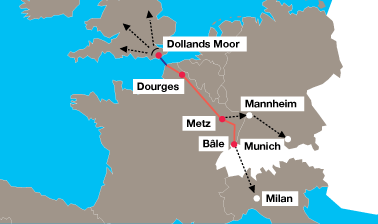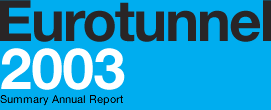
| September 1997 | Eurotunnel records its first operating profit |
| February 11, 1999 | The two millionth truck travels with Eurotunnel |
| March 24, 1999 | Eurotunnel named the greatest construction achievement of the 20th century |
| April 13, 1999 | On-line booking introduced on www.eurotunnel.com |
| June 21, 1999 | Eurotunnel announces plans to double truck shuttle capacity by 2003 |
Railways
Eurotunnel provides safe, efficient access for its railway customers, including Eurostar for high-speed passenger-only services between London, Paris and Brussels, and SNCF and EWS for rail freight services. Rail freight services through the Channel Tunnel fall into three main categories: intermodal containers and swap bodies, conventional wagons and international car transports
Eurostar
At 6,314,795 the number of passengers* carried through the Tunnel by Eurostar in 2003 fell by 4% compared to 2002. However, the fourth quarter saw an increase of 15% compared to the same period in 2002 following the successful opening of the first phase of the UK high-speed rail link on 28 September. This new line enables Eurostar passengers to travel between London and Paris in 2 hours 35 minutes, London and Brussels in 2 hours 20 minutes, and London and Lille in 1 hour 40 minutes.
* The passenger number given is for Eurostar passengers who travelled through the Channel Tunnel, and excludes passengers between Paris and Calais or Brussels and Lille.
Rail freight
Rail freight tonnage carried through the Tunnel increased by 19% to 1,743,686 in 2003 as the service continued to recover from the disruption to services caused by asylum-seekers during 2002.
Revenues from Eurostar and Rail Freight services through the Tunnel are protected by the Minimum Usage Charge paid to Eurotunnel by the Railways. This agreement continues until November 2006.
Eurotunnel: a trans-European rail freight operator
With the European rail freight market opened up to competition on 15 March 2003, Eurotunnel applied to the French transport and maritime secretary for a Railway Operator's Licence. This licence will enable Eurotunnel to develop new point-to-point traction services for complete trains between the Continent and the UK. A new subsidiary company, Europorte II, will undertake this activity. The first international connection will be between Italy and the UK. This service should begin by the end of 2004 or early 2005 with five trains per week in each direction, rising to 30 trains per day in each direction by 2008.


A new rail freight terminal in the UK
Eurotunnel has started work on a new intermodal freight terminal on its existing terminal site in Folkestone. This terminal will provide the only access to UK markets for continental gauge rail freight wagons. The new terminal, FIRST (Folkestone International Rail Freight Services Terminal), will be operational in 2005. Initially, the terminal will be able to accommodate four trains per day in each direction, representing around one million tons of rail freight per annum. It will be equipped to handle "piggyback" trailers, highcube swapbodies, and containers on conventional flat wagons.






 Next Page
Next Page Previous Page
Previous Page